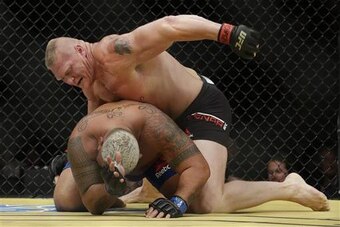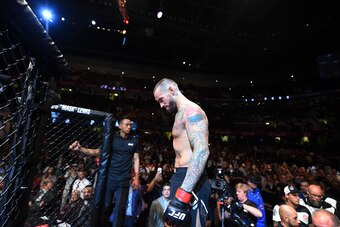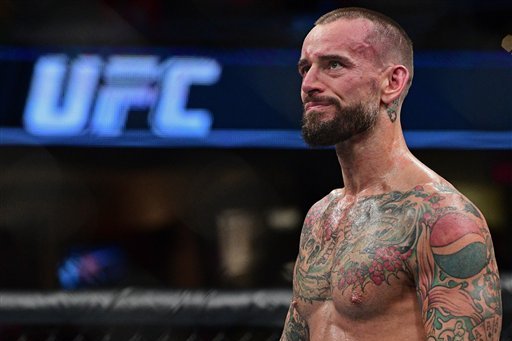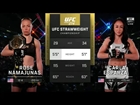The problem with CM Punk was he’d never done this before.
Well, that was one problem.
Among the many other things hampering Phil Brooks during his MMA debut at UFC 203 this month was the fact the former professional wrestler was making his first foray into competitive sports at nearly 38 years old.
From the footage we’d seen of him leading up to his highly publicized fight against Mickey Gall, he didn’t look like a particularly gifted natural athlete, either.
But mostly it was the sheer naivete that did him in.
You could see it in the sloppy right hand Punk tried to throw during the opening seconds of their welterweight fight and the ease with which Gall ducked under it for a takedown before the strike even got halfway to its target.
You could see it in the “Oh No!” face Punk made when he realized Gall was taking him down.
And yes, you could see it in the way Punk then floundered around on the ground, accepting punches from all angles before Gall forced him to tap with a rear-naked choke two minutes, 14 seconds into the first round.
That is horrific from CM Punk doesnt get any worse #UFC203 pic.twitter.com/3Jdz0Vycyg
— Karl (@karlt187) September 11, 2016
None of this was a surprise to the people who’d been paying attention.
Punk wasn’t signed and immediately booked into a UFC pay-per-view bout because he was expected to win—or even do well. His signing was merely the latest out-of-the-box promotional move by an increasingly profit-minded company amid a free-agent market that has sneakily gotten more and more competitive over the last few years.
Punk came, he saw and was conquered. All indications are that the now 0-1 MMA rookie will live to fight another day in the UFC.
The real question is: Will this sort of thing become a trend? Will the wave of the future in the UFC and across the MMA industry be—gasp—inexperience?
Roughly 24 hours after Punk implored the kids at home never to give up on their dreams during his classy but beat-up postfight interview, decorated amateur wrestler Kyle Snyder tweeted that he wants to be next:
I want to fight @ufc
— Kyle Snyder (@Snyder_man45) September 11, 2016
Snyder, an Olympic gold medalist and NCAA champ currently in his junior year at Ohio State, was ringside at UFC 203 in Cleveland. Apparently, he was pretty impressed with the show. So impressed, he wants in—like—right away.
The 225-pound Snyder told Fox Sports’ Damon Martin he thinks he could make a go of it as a professional fighter while simultaneously pursuing his dream of winning a second gold at the Olympics in 2020.
"[The UFC] put on a great show, it's really exciting,” Snyder said. “I think it's something that I could excel in. I haven't done much boxing or jiu-jitsu or striking or stuff like that but I think that I could pick it up pretty quickly."
Let’s be clear: Punk and Snyder are obviously members of two very different species of fighters.
Snyder’s elite wrestling background would make him an immediate blue-chip prospect, perhaps a future champion in either the light heavyweight or heavyweight divisions. Yet, if he were indeed to ink a deal with the UFC, he’d be entering the highest level of MMA just as Punk did: At 0-0.
He’d be cutting the line, so to speak.
Since Snyder’s first move was to tweet his intentions to enter MMA directly at the UFC, it appears he’d want to go straight from the wrestling mat to the Octagon. He might well have the chops to do it, too, but such a direct path would eschew the more traditional maturation process of getting at least a few fights under his belt on the independent circuit.
For a guy of his caliber, that would be unorthodox but certainly not unprecedented.
Brock Lesnar came to the UFC on the strength of his own NCAA wrestling championship and exactly one previous MMA fight. It didn’t hurt, either, that Lesnar enjoyed the double-whammy of also being a popular WWE superstar before crossing the aisle.
It seemed to work out OK for the enormous South Dakota native, as Lesnar won the UFC heavyweight championship in his fourth pro fight. He also nearly instantaneously became one of the fight company’s biggest-ever pay-per-view draws.

Yet it’s worth wondering if Lesnar would have had even more success in the cage had he been allowed to evolve like a normal up-and-comer. As it stood, his wrestling prowess and natural athleticism carried him farther than one might have imagined.
Still, by the time he fought guys like Shane Carwin, Cain Velasquez and Alistair Overeem, it was clear Lesnar’s all-around MMA skills lagged behind the best of his peers. His striking never had the chance to catch up with his grappling, and even when he returned for a comeback fight against Mark Hunt at UFC 200, he was still a liability on his feet.
For a guy like Snyder, the same phenomenon might turn out to be true. Certainly a neophyte like Punk would’ve had more opportunity for success had he started small and worked his way up, instead of being dropped directly into the Octagon.
There’s a reason such a trajectory has historically been rare, after all. The UFC has always been something to aspire to for young fighters. Depending on the depth of talent in their weight class, people might have to scrap their way through six, 10 or even 20 bouts before finally scoring their sought-after UFC contracts.
Fighters like Matt Mitrione and Amir Sadollah—who each made their professional debuts in the UFC after stints on The Ultimate Fighter—were an extreme rarity.

It’s possible, however, that’s starting to change ever slightly. More and more, the UFC and its main competitors at Bellator MMA appear to be snapping up potential talents and promotable personalities as early as possible.
Perhaps for no other reason than so the competition can’t land them.
To that point: Veteran MMA and pro wrestling reporter Dave Meltzer has publicly mentioned that Bellator had also expressed interest in Punk. Had the UFC not signed him, Bellator may well have done it. So perhaps once Punk decided he was making the jump to MMA, there was no way to avoid the sad spectacle of his debut happening before a large audience.
Maybe it was just a matter of determining which platform would carry it.
Regarding Snyder’s future, it’s also worth mentioning that the UFC already has another Olympic medalist—Russia’s Bilyal Makhov—under contract.
The 29-year-old heavyweight won the bronze in freestyle wrestling in 2012 to go along with his three world championships and signed with the UFC in September 2015. Makhov still has not made his professional MMA debut, but when he does, he’ll immediately become someone to watch in the puddle-shallow 265-pound division.
“To conquer this new mountain called UFC will give me new emotions, new feelings, new challenges—kind of like a rebirth and start everything from zero,” Makhov told UFC.com’s Jorge A. Moncada at the time of his signing. “This is what I want to get out of it. I want to get that feeling of rebirth and start all over again.”
Bellator too has been actively scouting for unproven but potentially elite talent. As America’s second-largest MMA promoter, company CEO Scott Coker has arguably had to be even more aggressive in his efforts to lock up prospects before they become established MMA stars.
Perhaps Coker’s biggest splash came in November 2014, when he signed wrestling wunderkind and former Golden Gloves champion Aaron Pico to a long-term deal just a month after Pico turned 18. At the time of the signing, Coker said Pico had “all the makings of MMA's next great superstar," via MMA Fighting.com’s Luke Thomas.
Two years later, he has yet to fight for Bellator but remains a member of the highly regarded American Kickboxing Academy and just missed qualifying for the 2016 Olympics in wrestling. When he does debut, Pico is expected to be a featherweight.
In 2015, Bellator also signed standout wrestlers and MMA hopefuls Ed Ruth and Tyrell Fortune. In 2016, the fight company added the likes of Jarod Trice and Joey Davis.
So far, only Davis has fought for Bellator—scoring a unanimous-decision victory in his welterweight debut in August—but their presence on the roster alone raises interesting possibilities for the future of a company that sometimes seems as though it will do anything to make a splash.
Make no mistake, however, any time a top-ranked MMA promotion takes on an athlete with zero fights, it’s most likely going to turn into a long-term undertaking. After the UFC signed Punk in December 2014, for example, he took nearly two years to try to make himself Octagon-ready.
Even then, and after an injury had delayed his eventual bout with Gall, he looked woefully unprepared.
In the big picture, though, perhaps this is the next natural development for the MMA market.
Maybe it’s just one iteration of a newly competitive industry, where talent is at premium. If not a full-scale shift, it at least represents a developing willingness to take on projects rather than market-ready commodities.
Another thing competition might breed among fight promoters is desperation. As we forge into MMA’s uncertain future, it’s highly possible that spectacles like Punk and legitimate prospects like Snyder begin making earlier and earlier appearances on the big stage.
Will that negatively affect the product?
Will it positively affect the bottom line?
Only time will tell.
It’s possible, however, that fans should get used to seeing more inexperienced fighters mixed in with the usual seasoned pros at the sport's top level.






























